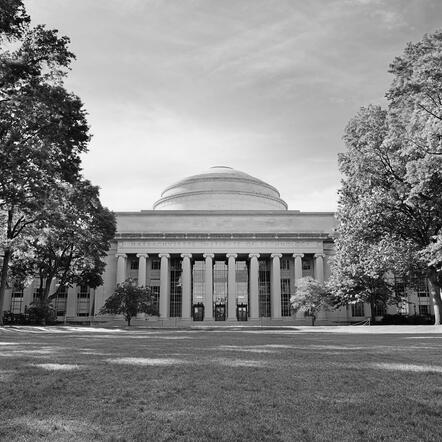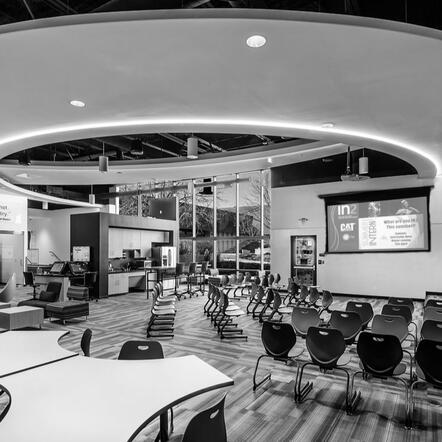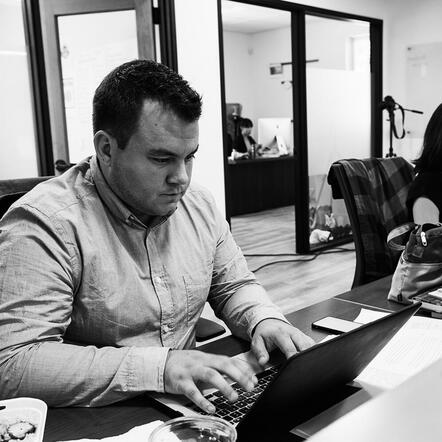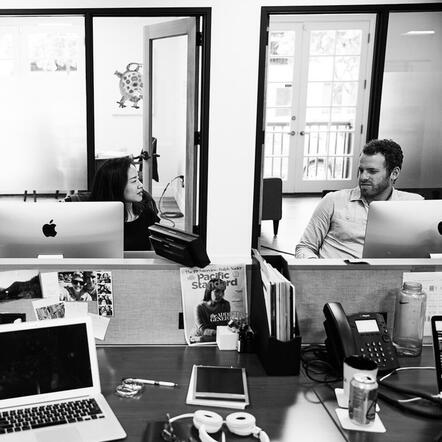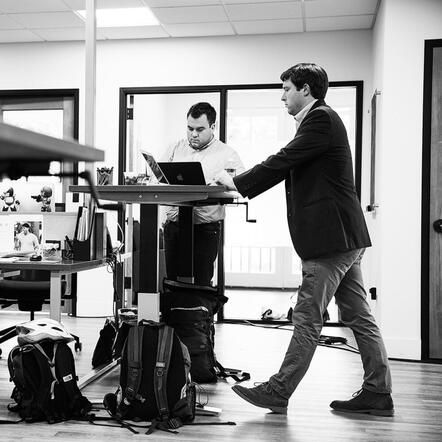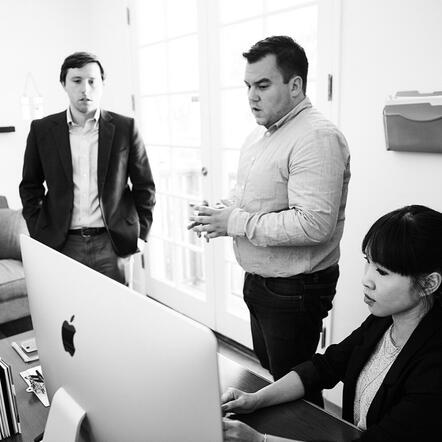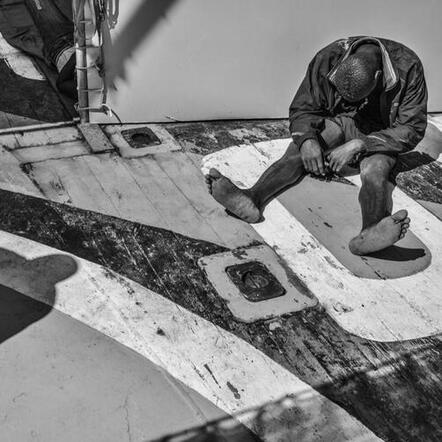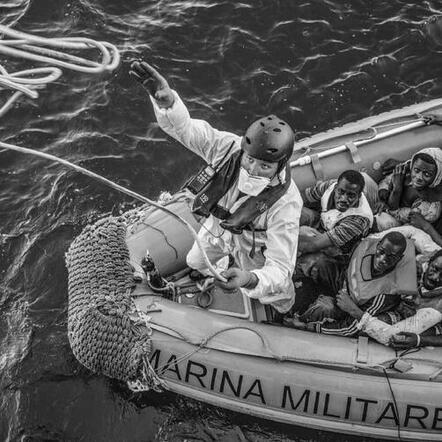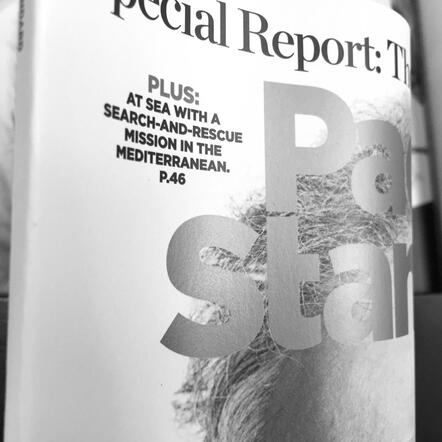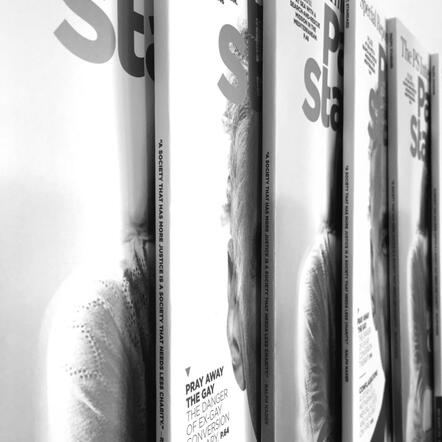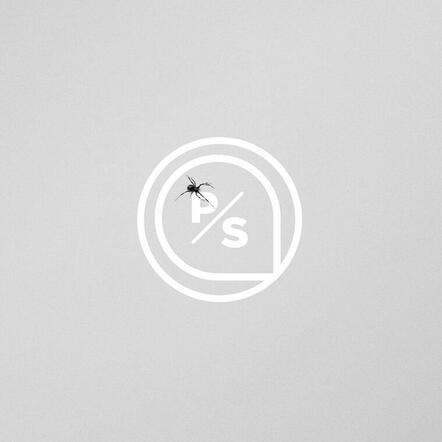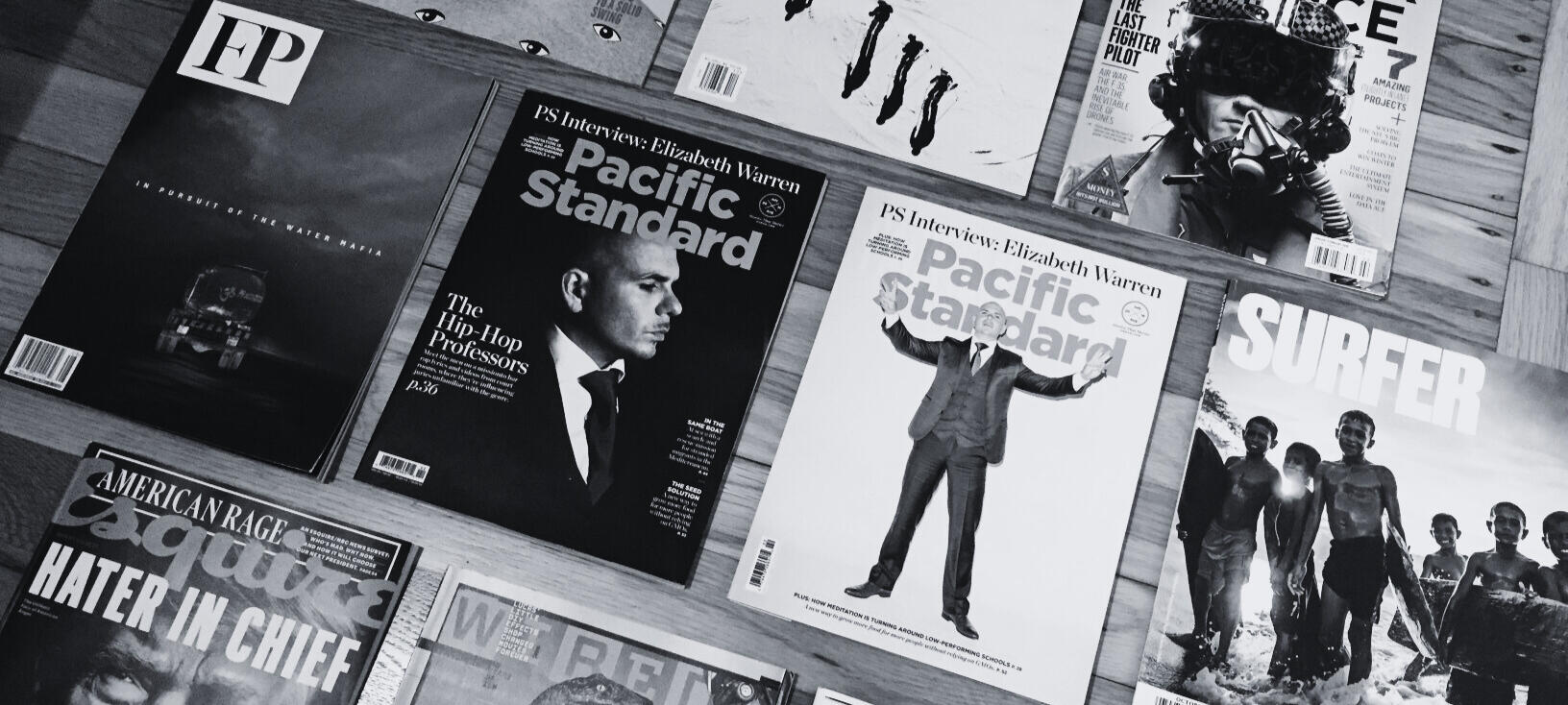
Fifth Gate Media
A vehicle for consulting on editorial and digital growth/content strategy; freelance reporting, editing, and project management; media literacy efforts; and entrepreneurial experiments in journalism and tech or start-up environments. —— Nick Jackson
→ Hire and coach best-in-class reporters and writers. / Commission and edit award-winning, needle-moving stories. / Rapidly scale audiences on owned and operated platforms. / Implement data-driven cultures that embrace experimentation and SEO. / Launch products: print magazines, contributor networks, branded content.I've worked on all kinds of editorial and content projects, from commissioning and editing individual stories and themed packages to overseeing the development of books, journals, and conferences to improving existing programs by applying lessons I've learned running and scaling large editorial teams and business operations over 15 years (about newsroom engagement and morale, newsletters and distribution, the use of new tools and technologies, standards and best practices, and more). I love a challenge, and I try to make the media landscape just a little bit better every day. If you've got an idea that needs executing, a project that needs work, or a team that needs a fractional CCO or EIC, let's chat.
Some of What I've Done — and Can Do for You
Range: Commission, edit, and produce, from idea to finished product, editorial coverage — investigative reports, features, story packages, essays, news, service journalism — across a variety of subjects, including technology, science, health, extreme sports, social and environmental justice, climate change, work culture, and professional development. Hire me to launch a features program; fill in for an editor on leave; execute your vision; or scale an existing editorial function.
Support Systems: Run your editorial or content team more efficiently by auditing and improving existing systems, including story tracking, freelance onboarding and payment programs, and automation tools. Leverage new technologies like generative AI and machine learning to unlock new levels of growth and audience engagement.
Branded Content: Develop a content strategy that will benefit your bottom line and improve your relationships with customers or clients, delivering on business goals better than any marketing program or advertising campaign ever could, while creating work of editorial value that your users will actually find useful and actionable.
Grants: Solicit support from funding partners to expand your editorial, freelance, or travel and expense budgets with clearly defined packaging and promotion ideas.
Editorial Standards + Processes: Develop and implement attribution, article and quote review, and correction policies that improve the value of your content; design copy-editing, fact-checking, and legal review processes — all of the hallmarks of a best-in-class journalistic product that identify you as a thought leader.
Editorial Products: Collaborate across product, engineering, growth, and/or marketing teams to build and launch new editorial products (homepage redesigns, a dictionary, newsletters, paid products and services, new coverage areas, a licensing program, brand extensions, special packages) that increase content discoverability, generate revenue, improve user experience, and put your brand in front of new audiences.
Goals + Metrics: Assemble ambitious goals and OKRs that encourage your team to work and collaborate more effectively while improving newsroom morale and engagement by getting reporter and editor buy-in and keeping mission front and center.
Distribution: Scale content newsletters (I've taken one from 51,000 to 1.2 million opt-in subscribers without advertising or marketing) using focused curation, machine learning models, and/or personalized recommendations to improve user retention.
Content Freshness: Create an updates and optimization program to keep large content libraries fresh and accurate for current readers while prioritizing stories that will over-perform in attracting readers or delivering gated assets to leads.
Expert Contributors: I added dozens of healthcare practitioners to The Atlantic's contributor pool when launching the health section there; worked with prominent social and behavioral scientists as the editor-in-chief of Pacific Standard; and helped to attract hundreds of contributors, including some of the biggest names working in tech, to Built In. Leverage professionals to supplement your team's original reporting with expert commentary and analysis that stands out.
User-Generated Content: Build a process for soliciting and encouraging user-generated content submissions using lessons learned from serving as the first editor-in-chief of Atlas Obscura, a 20,000-strong collection of wondrous places around the world.
Talent Recruitment: Identify and recruit top editorial talent across a wide range of content verticals and areas of specific expertise in publishing and leadership.
Books + Journals: With support from the Howard Hughes Medical Institute's Department of Science Education and the Kavli Foundation, I worked with the KSJ Fellowship at the Massachusetts Institute of Technology to create and execute a strategy to assemble a 300-page guidebook for meeting the highest standards for quality in science journalism. I recruited some of the most well-known science reporters and editors working today, and coached them to provide their tips and advice to others.
Expertise + Authority: Improve your search engine rankings, win more SERPs, and make it clear to readers why you're the definitive source on a certain subject or subjects by showcasing expertise, experience, authority, and trustworthiness.
Awards + Honors: Stories, photo essays, and editorial packages I've commissioned have won the National Magazine Award, the Society of Publication Designers' Silver Medal, the Sidney Hillman Foundation Award, the AAAS Kavli Science Journalism Award, the Mirror Award for Best Profile from the S.I. Newhouse School of Public Communications, the National Association of Science Writers' Science in Society Award, arts and entertainment awards from the Los Angeles Press Club, and many others.
Panels + Public Speaking: I've participated in several panel discussions on the future of journalism, combating fake news, and building more collaboration within and among media outlets, and have discussed my team's work on various international radio and television programs, including the BBC Radio 1 in the United Kingdom, “Q” on Canada’s CBC Radio One, and C-SPAN’s “Washington Journal.” I've also interviewed several public figures of note, including the political commentator and former White House Press Secretary Bill Moyers and Canadian author and social activist Naomi Klein in front of sold-out crowds at the Granada Theatre in Santa Barbara, California.
Books + TV: Articles I've edited have been optioned for film, television, and radio; expanded into books; and reprinted in numerous anthologies, including Best American Essays, Best American Food Writing, Best American Science and Nature Writing, and What Future: The Year’s Best Ideas to Reclaim, Reanimate & Reinvent Our Future.
Change Management: I've scaled editorial functions up and down depending on market forces and led teams through major reorganizations and restructuring; let me help you do the same in a smart, focused way that involves everyone on your team.
Growth Adviser: I provided strategic advice to the co-founders of Beacon Reader, part of Y Combinator's 2014 class, helping to raise over $1,000,000 via 20,000 online donors to fund journalism, including $40,000 for a HuffPost fellowship to cover protests in Ferguson for a year, $46,000 for six climate reporters to create a micro-publication, and support for a Texas Tribune series on energy developments.
Establish Partnerships: I believe combining forces often results in better journalism. To that end, I've developed innovative partnerships with The Marshall Project, the Food and Environment Reporting Network, The Guardian, Magnum Photos, the Pulitzer Center on Crisis Reporting, and others in order to fund high-impact, ambitious reporting — in writing, photographs, and audio — in the public interest.
Employers
Visit my LinkedIn for an up-to-date list of previous employers — Pacific Standard, The Atlantic, etc. — and key accomplishments.
Publications
The KSJ Science Editing Handbook: A product of the KSJ Fellowship at the Massachusetts Institute of Technology, with support from the Howard Hughes Medical Institute's Department of Science Education and the Kavli Foundation, this handbook is a 300-page guide to meeting the highest standards for quality in science journalism. In it, many of the most celebrated science editors and reporters working today share their insights, knowledge, and best practices for others to adopt.
The Postscript: A guide to stories that matter — and how they're made. We share the best reporting and writing being done today, and support the people and processes behind it. By amplifying the work of quality journalists and journalism outlets, and sharing tips, lessons, and other resources, we aim to help those in media to do their jobs well, and also to make smarter news consumers of us all. (Launched with support from Substack's creators program, in part to experiment with scaling paid email.)
Officer: IALJS — Evanston, IL
The International Association for Literary Journalism Studies' mission is the improvement of scholarly research and education in literary journalism and reportage — not journalism about literature but journalism that is literature. To accomplish this, the association works to encourage critical and cross-cultural research and enhance content standards and instruction in courses.
Since June of 2010, oversee all development and maintenance of the association's website and digital presence; contribute to the production of a peer-reviewed bi-annual academic journal, Literary Journalism Studies, and annual international conference that brings together top journalism educators from around the world.
Story Editing
Stories, photo essays, and editorial packages I've commissioned and edited have won the National Magazine Award, the Society of Publication Designers' Silver Medal, the Sidney Hillman Foundation Award, the AAAS Kavli Science Journalism Award, Syracuse University's Mirror Award, the National Association of Science Writers' Science in Society Award, and many others. They have been optioned for film, television, and radio; expanded into full-length books; and reprinted in numerous anthologies, including several Best American collections. These are some of my favorites:
Investigations
Children of the Tribes, Julia Scheeres: In this country, we celebrate the First Amendment, which prevents the government from interfering with religious beliefs and practices. But what if those beliefs and practices make children suffer?
Failure at the EPA, Kevin Stark + Winifred Bird: The agency has left immigrants and minorities to fend for themselves at toxic waste sites across the country.
Endless Addiction, Jack Shuler: The opioids are here, and meth is resurgent. When it's easier than ever to rationalize the first hit, and the options are limitless, even a community-wide effort might not be enough to stop the overdoses. A year in the heart of the addiction crisis in Rust Belt America.
Profiles
The Messengers, Brooke Jarvis: How do we get people to care about the environment? What if we're asking the wrong question?
The Battle for the Great Apes: Inside the Fight for Non-Human Rights, George Johnson: With several incremental victories behind them, animal-rights advocates are making their biggest push yet: to expand the definition of a person.
The Bionic Woman of Good Science, Bonnie Tsui: How an ecologist of tidal communities became a global diplomat for the ocean.
Features
The Country's First Climate Change Casualties?, Elaina Plott: Scientists predict Tangier Island could be uninhabitable within 25 years. This is the story of the people willing to go down with it — and why they've risked it all on Donald Trump to keep them afloat.
Bringing the Rural Poor Into the Digital Economy, Maria Konnikova: Dumas, a small town in the heart of the Arkansas Delta — where public computers and open Internet access are hard to come by — is home to an ambitious new program to teach digital literacy skills.
The Poison in Our Water, Morgan Baskin: As scientists sort out the best way to capture and measure the harmful microfibers that now litter most of the world's freshwater, we have no choice but to keep drinking.
This Is Your Brain on Poverty, Karen Weese: How behavioral economics is opening a creative new front in the fight against inequality.
Fighting Back Against Parkinson's, Tovin Lapan: Individuals struggling with the mysterious, debilitating disease are finding relief in an unlikely place: the boxing gym, where patients battling uncontrollable tremors are transformed into fighters.
Reported Essays
Engineering a More Perfect World, Barrett Swanson: Jacque Fresco spent decades building a life-sized model of his ideal city. The central idea? If we want the Western world to overcome war, avarice, and poverty, all we need to do is redesign the culture.
The Afterlife of Big Ideas, Michael Hobbes: How one high school — mine — explains why we keep making the same mistakes in education reform.
Could California Become a Zero-Extinction State?, Jimmy Tobias: California plant lovers are finding — and nurturing — species once presumed to be extinct in the wild.
Story Packages
Unseen America: Pacific Standard sent five freelance reporters, most of whom grew up and still live away from the coastal media centers, to expose some of the struggles and challenges being faced by the misunderstood middle of the country, shining a spotlight on people and places that are often left out of the political conversation.
The 50 States Project: For a special package that we're calling The 50 States Project, we've spent six months asking writers, artists, and thought leaders from every state in the nation to outline some of the biggest problems and most hopeful solutions happening in each. This ambitious project will anchor a cover-to-cover look at the new American narrative — an investigation into civic action and cultural leverage points that are different from what's been seen before in this country. We've found stories that chronicle unprecedented phenomena, activism, and efforts happening domestically in response to our nation's polarization. Our hope is that, by putting all of these stories — and solutions — together in one issue, we can find where to focus our energy to effect the most change.
Photo Essays
Adrift, Francesco Zizola: An unprecedented number of refugees are boarding unseaworthy vessels for a dangerous crossing.
Stories of Forbidden Love, Robin Hammond: Photographing LGBT citizens in countries where homosexuality is still criminalized.
In the Land of Hope and Grief, Kiliii Yüyan: An art therapy project in an Alaska Native village helps teens talk about suicide in their community.
Partnerships
A Journey Through Contested Lands: Six photographers, in collaboration with Magnum Photos and with support from the Pulitzer Center on Crisis Reporting, went out into six remote regions of the world where Indigenous communities are waging unseen battles against governments and commercial interests to remain on their ancestral lands. They came back with stories and photographs that span the globe, from Honduras to Malaysia, for a special print issue. Photography from "A Journey Through Contested Lands" was put on display at the World Affairs Auditorium, and a school lesson plan was developed for teaching Indigenous rights and resistance through photo essays.
The Endling: Watching a Species Vanish in Real Time, Ben Goldfarb: On the frontlines of extinction in the Gulf of California, where the vaquita faces its final days. This article was produced in collaboration with the Food & Environment Reporting Network.
The Catalyst, Abbie VanSickle: Thelton Henderson transformed California's criminal justice system. Now comes the backlash. This piece was produced in collaboration with The Marshall Project, a non-profit news organization that seeks to create and sustain a sense of national urgency about the U.S. criminal justice system.
The Lost Art of Listening, Joel Oliphint: Sound artist Brian Harnetty wants to transform the future of Appalachian Ohio's forests through radical acts of listening. This story was produced in collaboration with Columbus Alive, a news outlet in Ohio.
Big Oil's Black Mark on California's Climate Record, Kate Wheeling + Jim Morris: The state's oil regulator has the dual burden of facilitating oil development while protecting the environment and public health. Can it do both? This piece was produced in partnership with the Center for Public Integrity, a non-profit investigative news organization in Washington, D.C.
Select Clients
Focused primarily on magazine-quality journalism — in all formats, at all lengths, and across industries and platforms — and the structure, staffing, and processes necessary to support it, I provide strategic advice, growth/distribution consulting, and editorial services to a variety of publishers and organizations looking to tell great stories that have the potential to influence everything from a business' bottom line to public policy.
Blue Titan Ventures: Provided strategic direction and networking support for this early stage venture capital syndicate seeking media coverage following a round of investments in the machine learning and artificial intelligence communities.
Considerable: A New Media Brand for People Redefining What It Means to Grow Older: Developed a features program in late 2019 and early 2020, setting up new contracts and payment processes and commissioning and editing a number of long-form original features, including Gabriel Furshong's story about the lessons he learned from 113-year-old Walter Breuning and David Silverberg's profile of the longevity explorers, a group focused on making sure that the concerns of older adults are heard in the development of products that are intended for them.
The Atlantic: Video Strategy + Homepage: While working at The Atlantic editing science and technology coverage and overseeing the development and launch of a new section devoted to health coverage, part of a two-person team that conceived of — and developed a launch plan for — the magazine's video strategy; worked with the product, marketing, and engineering teams to contribute to homepage and site re-designs.
World Sport Chicago: Worked with World Sport Chicago, an independent non-profit organization that supports resiliency and strengthens community by increasing access to youth sport, to produce hundreds of pages of digital editorial copy and marketing materials for Chicago's bid for the 2016 Olympic and Paralympic Games.
The Illinois Mathematics and Science Academy: Collaborated with Cathy Cousins Veal, the president of The Illinois Mathematics and Science Academy in the suburbs of Chicago to develop outreach and communication strategies, plans, and materials — after observing and interviewing dozens of students, alumni, staff, and faculty — in support of the experimental residential high school's strategic action plan to develop IMSA as a teaching and learning laboratory for imagination and inquiry.
Edelman Digital: Served as a temporary community manager for Edelman Digital, designing and overseeing the launch of a new public-facing website for the digital arm of the world's largest private public relations and marketing consultancy firm.
Advisor: Beacon Reader — San Francisco, CA
The Web has changed the way we produce and consume information, but the reader-writer relationship remains the same. Journalists have stories to tell; readers are listening. Beacon was a simple platform, built by industry professionals and technologists, that let writers connect with readers that value their work.
Provided strategic advice and consulting to the co-founders, part of Y Combinator's 2014 class, from June 2013 to September 2016; recruited high-quality independent journalists to participate at launch; raised over $1,000,000 via 20,000 online donors to fund journalism, including $40,000 for a HuffPost fellowship to cover protests in Ferguson, Missouri, for a year, $75,000 for Shane Bauer to write about working undercover as a private prison guard, $46,000 for six climate reporters to create a micro-publication, and support for a Texas Tribune series on energy developments.
Social Science Foo Camp — Menlo Park, CA
Held at Facebook HQ in 2018, this invite-only event brought together 250 of the world's leading technologists and policymakers to discuss the future of social science, the impact of technology, and the possibilities for cross-discipline collaboration.
Secured $50,000 in funding from the Sloan Foundation to support travel grants for attendees from non-profits and academia; participated in multiple panels and discussions covering human interactions with digital systems, online communities, algorithmic bias, and the effect of West Coast tech culture on research and policy (attendees included Daniel Kahneman, Alison Gopnik, Tim O'Reilly, and others); organized event with support from Facebook (venue, catering, transportation), SAGE Publishing (hotels); and O'Reilly Media (logistical support, conference materials).
Women + The Environment — Santa Barbara, CA
A 2017 forum to connect and create, this two-day conference was designed for changemakers looking to establish new partnerships and be effective agents of adaptation to climate + social change.
Interviewed social activist Naomi Klein following her keynote address to 1,500 attendees at Santa Barbara's historic Granada Theatre; facilitated discussions on environmental activism and climate change (attendees included Michelle Romero from Green for All, Paula Daniels from Good Food Purchasing, and others).
Awards + Honors
National Magazine Award, Essays + Criticism — Finalist (2019): "In an essay the judges found especially affecting, Terese Marie Mailhot explored the paradoxes that permeate her life as a Native American writer navigating a white world."
National Magazine Award, Feature Photography — Winner (2017): "Sensitively paced and complemented by elegant typography, Francesco Zizola's photographs of migrants attempting to cross the Mediterranean [in 'Adrift: At Sea With a Search-and-Rescue Mission'] combine a strong visual perspective with a powerful narrative voice."
Folio: Magazine, 30 Under 30 (2017): "Since assuming leadership of Pacific Standard in 2015, Jackson has renewed the magazine's editorial vision. With limited resources, Jackson has made PS a must-read for those working on solutions to social problems."
Folio: Magazine, 15 Under 30 (2012): "With just over five months under his belt as editorial director for Outside, Jackson has taken the reins on the magazine's digital presence. Outside's August 2012 audience is more than 4x that of August 2011."
Testimonials
Elaina Plott Calabro — Staff Writer, The Atlantic: "I owe my favorite feature to Nick. He took my brief musings and — effortlessly, it seemed — shaped them into an award-winning cover. Nick is all those things a great editor should be — empathetic, sharp, intuitive. But he's also a total blast to work with. In this fraught moment, I cherished writing for someone who not only understands the power and urgency of a good story, but also knows how to have fun in the process of telling it."
Barrett Swanson — Contributing Editor, Harper's: "In addition to his generosity and insightfulness, Nick is that rare editor, one who can glimpse into the core of a story and locate its most powerful iteration. While helping me with a story, Nick teased out latent ideas in the draft and helped me express them forcefully. Any writer would be lucky to receive his stewardship and intelligence."
Jimmy Tobias — Contributing Writer, The Guardian: "When I was a brand new reporter, Nick took a chance on me. He worked patiently to help me hone my narrative voice and deepen my reporting skills. He also gave me space to experiment. Our work together led to a long series of feature stories and investigative articles about environmental controversies and political upheaval in the American West. Those stories were the foundation on which I built my career as a freelance investigative journalist. I wouldn't be where I am today without Nick's wise counsel and his keen eye for editing. I am so grateful for his guidance, and you will be too."
Kevin Lincoln — Documentary Producer: "Nick understands something rare and extremely desirable in an editor: how to approach his craft from both a micro- and macrocosmic perspective. He'll make your sentences better and your paragraphs tighter, but he'll also help shape and fine tune the greater argument and narrative of the piece; he cares about how it's written as well as what it's saying. At the same time, he has the gift of knowing where not to edit, which is just as rare and desirable a quality. He understands how to protect the writer's intrinsic voice and vision, even when cuts need to be made, and he doesn't edit just to make his presence felt. (And this doesn't even cover his abilities as an EIC, which were obvious in the breadth, depth, and imagination of Pacific Standard during his tenure.) I've always been in great hands with Nick as an editor, and I can't imagine anyone feeling differently."
Lois Parshley — Snedden Chair of Journalism, The University of Alaska: "Nick is one of the few editors who understands the shape of the industry today and has a vision of how to make it better. It was a pleasure to work with an editor who focused not only on crafting a good story, but was concerned about its impact."
Jack Shuler — Director of Journalism, Denison University: "Nick is one of the finest editors I've ever worked with. He took a flat story and transformed it into one that truly moved, and I think haunted, readers. It's not something I could have done on my own. Nick is an editor with a vision for stories and their impact on both people and policy — the kind of empathetic approach that journalism needs in this moment."
Michael Hobbes — Host, Maintenance Phase: "Nick is one of the smartest editors I've ever worked with. He turned a sprawling, 8,000-word mess into an actual story. He's patient, thoughtful, and ruthless in track changes when he needs to be."
Pamela Colloff — Staff Writer, The New York Times Magazine: "From the first day I met Nick, I was struck by his intellectual curiosity, his creativity, his irreverent humor, his energy, and his confidence. Nick was never intimidated by the power structure at Texas Monthly, which can be hard to break into. He kept knocking on doors until everyone knew who he was and had given him work to do."
Kevin Stark — Senior Editor, KQED Science: "By the time I spoke to Nick about my idea to investigate two dozen places across the U.S. where extremely toxic substances pose a direct health threat to immigrants, several editors already told me to think smaller. But he encouraged me to take a big swing. Three years later we published 'Failure at the EPA' as a cover story. Nick took me all the way from idea to publication. He can see the big picture, the important details, and a damn good story. He is a fantastic editor and a pleasure to work with."
George Johnson — Author, The Cancer Chronicles: "Nick is one of the best editors I've worked with — inspired, meticulous, and thoroughly professional."
Charles Whitaker — Dean, Northwestern University's Medill School of Journalism: "Nick is a very bright and resourceful editor who is brimming with ideas. If you are looking for an industrious and hard-working young editor, you need look no further."
Media Predictions
2023: There Will Be Launches — and We'll Keep Doing the Work: "Media is always evolving. This constant cycle of two-steps-forward, two-steps-back can be disorienting, but it has allowed us to more quickly bring in new people, often those previously excluded from our newsrooms. It means we can explore new ideas and opportunities; we can reach new audiences. Every time, the media that steps forward looks a little different from the one that stepped back."
2021: Blogging Is Back, but Better: "These blogs, these magazines, these whatevers, will be built and guided by the individual creators for their audience, not by the executives they once reported to or their shareholders and owners. Maybe these will live on Substack 2.0. Or they'll live on Lede, a new publishing and subscription platform from the people behind Alley. Or they'll look completely different from either of those things. It won't matter much to readers, who all benefit from the great re-bundling. Or to writers, who have an opportunity here to create a more fair and equitable media industry, this time from the bottom up."
2020: What's Left of Local Gets Comfortable With Reader Support: "What if we thought of those subscribers as something other than customers to put advertising in front of? What if we thought of them as readers first, with ideas about what kind of information might be most valuable to them, and the funds to fuel its creation?"
2019: More Transparency Around Newsroom Decisions: "We're constantly reminded that audiences are increasingly distrustful of news — who's producing it, how it could have been influenced, whether it's 'fair and balanced' — and they're asking questions of us that they haven't always in the past. Folks in many of the newsrooms I'm aware of are thinking through ways to combat this distrust and position their outlets as consistently reliable. The results of those brainstorming sessions are starting to make their way to the public, but I anticipate we'll see a lot more experimentation around opening up the editorial process to regular, and even occasional, readers."
Press
James Fallows / The Atlantic: "Back in my youth, I liked to say that the purpose of journalism was to 'make what matters interesting.' It's easy enough to make interesting things interesting … and it's even easier to make important things dull. What makes journalism different from entertainment is that it is supposed to deal with 'real' issues. Presenting them in a way that holds people's attention — that's the standard journalism, in its different forms, is always aiming for. Terry Gross does it in one way. Michael Lewis in another. PS is earning a place on that list."
The Los Angeles Times: "Pacific Standard is a bimonthly that focuses on social issues and public policy with the same passion that supermarket glossies lavish on Bigger Loser spreads and Heidi Montag's latest turn under the surgeon's knife."
Sarah Laskow / Columbia Journalism Review: "PS relaunched with a new website — more mobile- and tablet-friendly, more Obama-era sans serif blue. In the past year, the staff has grown too: Jackson, an editor who has thought hard about how to make the Internet work for places like The Atlantic and Outside, joined as digital director."
Keith J. Kelly / The New York Post: "Small, off-beat magazines dominated the industry's annual awards competition, beating back their better-known, better-financed rivals. In category after category, it was editors and brass from Time Inc., Hearst, and Meredith standing to applaud folks from Pacific Standard as they picked up their Ellie for excellence in publishing."
Simon Owens / Thoughts on Journalism, Medium: "As digital director, Jackson was charged with taking the bi-monthly and building a Web presence around it that included a healthy dose of digital-only content. It was around this time that the magazine began producing some blockbuster articles that reverberated well beyond the publication's headquarters into the larger media world."
Marc Tracy / The New York Times: "The loss of PS leaves digital media a little less brainy. 'Even when they were writing about the debate of the day or the moment, they were doing it in an intelligent way,' said Casey Cep, a former columnist who now writes regularly for The New Yorker, the New York Times, and other publications."
Interviews
Sinkhole: Storytelling Is at the Root of Making Change: "I mentioned stories that matter and that is the overarching objective — that idea guides everything we do. Every day we aim to find the stories that can make a difference. Sometimes, on our best days, we’re successful, and, when we are, the results can be impressive."
KCBX: Central Coast Voices: Pacific Standard: "Join host Fred Munroe as he speaks with editors Nicholas Jackson, editor-in-chief; Jennifer Sahn, executive editor; and Ryan Jacobs, deputy editor, as they discuss how Pacific Standard tells stories about society's biggest problems, and the people attempting to solve them."
Mr. Magazine: A Magazine Worth Printing With Stories That Matter: "Nick Jackson is editor-in-chief of Pacific Standard and has brought the brand into this redesign boldly and confidently, anxious to show readers the positive changes that have been made. Nick comes from a background that includes such giants in publishing as The Atlantic, Slate, and Outside magazines. He knows his stuff and is proud to be cultivating stories that inform and change people's lives."
C-SPAN: Washington Journal: Future of the Labor Economy: "Nicholas Jackson talked about his cover story in Pacific Standard on the future of the labor economy."
The OPEN Notebook: How Much Time Should I Spend Preparing a Pitch?: "A lot of people will tell you to stick to a three-paragraph pitch structure: introduce yourself and explain why you're the best person to tell this story, explain the story, and get out by convincing the assigning editor that this story is right for their publication. The first part is easy — I hope; the second two call for more work, and time. But this is silly. All publications are different; all editors are different; and, most importantly, all stories are different (or they should be)."
Nick is a National Magazine Award-winning editorial leader with 15+ years experience building and running large, ambitious, data-driven teams and driving exponential digital and revenue growth in director-level and editor-in-chief roles at tech startups and consumer publications including The Atlantic, Pacific Standard, and Outside. He consults for a wide variety of clients through his LLC, Fifth Gate Media, which serves as a vehicle for work on content and distribution strategy; freelance reporting, writing, editing, and project management; media literacy efforts; and other entrepreneurial experiments in both journalism and tech environments.After the usual high school and college journalism projects, he got his start by writing for Encyclopedia Britannica, where he was the first person to include the word “beatboxers” (in a profile of Björk) in the publication’s 250-year history; covering Barack Obama’s campaign as a new media intern (when that was a specialized job people had) for Texas Monthly; aggregating news for The Slatest, one of the first early morning newsletters, with an audience of 600,000; and reporting on Google, Facebook, Apple, and other big tech companies for The Atlantic. Some articles he wrote include a look at inventors killed by their own inventions, a profile of the customers who write thousands of product reviews on Amazon — and why, and a story on the men obsessed with exploring the deep ocean, for which director James Cameron wrote him an email claiming he should have been more prominently featured.After transitioning into editing and management, he sent reporters and photographers around the globe, including to Everest Base Camp to document a difficult and deadly climbing season on the world’s highest peak, the Northwest Passage to capture the effects of climate change, and six countries — from Honduras to Azerbaijan — where Indigenous communities waged previously unseen battles against governments and commercial interests to remain on their ancestral lands. He helped to make a magazine from start to finish over one 48-hour weekend; assembled a story package that brought together writers and high-profile public figures from all 50 states (plus D.C., and the five U.S. territories) looking for solutions to entrenched societal problems; has been advised by his lawyer not to visit the Maldives for the 10 years after green-lighting an intimate profile of a repressive regime; and developed innovative partnerships with The Marshall Project, the Food and Environment Reporting Network, The Guardian, Magnum Photos, the Pulitzer Center on Crisis Reporting, and others in order to fund high-impact, ambitious reporting, both written and visual, in the public interest.Along the way, he has 4x’ed the size of multiple editorial teams, nurturing a generation of newsroom talent with a special focus on diversity, ongoing professional development, and helping new voices to reach wide audiences (an interest that's also led him to conduct resume workshops for graduating journalism students and appear as a guest speaker in many journalism classes at universities across the country). He’s had the great privilege to work with, manage, or coach some of the best in the business, and collaborated with them to build contributor networks made up of more than 500 healthcare practitioners and technologists to supplement original reporting with expert commentary and analysis; created significant user-generated content functions (more than 20,000 published submissions) as the first editor-in-chief of Atlas Obscura; and scaled homepage traffic and email newsletters from 50,000 to 1.2 million subscribers using focused curation, machine learning models, and personalized story recommendations (while maintaining open rates above 45%).And he’s launched, or contributed to the launch, of new and creative editorial products and distribution mechanisms including a tech dictionary, educational coursework, art exhibitions, high school lesson plans, and more; and joined forces with growth, engineering, and business intelligence teams to stand up best-in-class SEO operations, design an updates program capable of keeping thousands of archival stories factually accurate and current for today’s readers, and leverage generative AI to support the production of large content libraries that adhere to strict standards. Particular strengths include developing and executing editorial strategy with a focus on launching new products, organizing and driving teams toward big goals and OKRs, and producing journalism of exceptional quality to drive significant audience growth.He believes editorial done well — and that anyone who does it has a responsibility to do it well — underpinned by advanced use of automation, analytics, and support systems and processes can reach more people and do more good than any marketing campaign or advertising program ever could. Journalism is a powerful tool. It can hold institutions accountable, elicit strong emotions, affect change. It can benefit both the bottom line and serve as a valuable, motivating resource for many.Stories, photo essays, and editorial packages he’s commissioned and edited — on subjects as varied as science and technology, health, extreme sports, social and environmental justice, career advancement and work — have won the National Magazine Award, the Society of Publication Designers’ Silver Medal, the Sidney Hillman Foundation Award, the AAAS Kavli Science Journalism Award, Syracuse University’s Mirror Award, the National Association of Science Writers’ Science in Society Award, and many others. They have been optioned for film, television, and radio; expanded into full-length books; and reprinted in numerous anthologies, including several Best American collections. They’ve been taught in classrooms, referenced in journal articles, and deployed by state and congressional leaders.As an editor, Nick has been praised for “maintaining a dedication to all kinds of diversity” and for “paying promptly and valuing writers.” It’s been said that “he cares about the future of publishing and isn’t afraid to innovate in an industry which desperately needs it” and, by Mr. Magazine himself, that “he knows his stuff and is proud to be cultivating stories that inform and change people’s lives.”He has participated in several panel discussions on the future of journalism, combating fake news, and building more collaboration within and among media outlets, and has discussed his work on various international radio and television programs, including the BBC Radio 1 in the United Kingdom, “Q” on Canada’s CBC Radio One, and C-SPAN’s “Washington Journal.” He has interviewed several public figures of note, including the political commentator and former White House Press Secretary Bill Moyers and Canadian author and social activist Naomi Klein in front of sold-out crowds at the Granada Theatre in Santa Barbara, California, where he was the third editor-in-chief of Pacific Standard, a national magazine that combined research with ambitious narrative and investigative reporting, from 2015 to 2019. (He had previously served as associate publisher, during which time he worked to create new revenue streams for non-profit journalism.) When the Columbia Journalism Review profiled the magazine in 2014 because it had “taken the Internet by storm,” heavy emphasis was placed on the then-recent site redesign spearheaded by Nick, brought in nine months earlier as digital director; writer Sarah Laskow described him at the time as “a young editor who has thought hard about how to make the Internet work for places like The Atlantic and Outside.” When he was appointed editor-in-chief the following year, Nick re-positioned the magazine to tell “stories that matter,” focusing most heavily on social and environmental justice.When Pacific Standard closed in 2019, it was written that Nick “led a superb editorial team over his six years there” and that the magazine “stood out from the pack of click-hungry websites.” James Fallows told the Los Angeles Times that “it’s been a really valuable part of the media ecology,” and that Pacific Standard had “been of national and international caliber for more than a decade without just getting into the standard political news fray.” The Daily Beast’s Lloyd Grove reported that the shutdown “hit the journalism community especially hard,” with other reporters noting that “I’ve looked to Pacific Standard so many times for examples of great, clear-eyed reporting and elegant (but never over-the-top) writing” and that “Pacific Standard was the best dedicated source for social science coverage anywhere, and routinely put out stories that made me burn with jealousy that I didn’t think of them first or do them as well. The world will be worse without it.”Prior to joining Pacific Standard as digital director, Nick was the digital editorial director of Outside in Santa Fe, New Mexico, where he was responsible for all online efforts — website, newsletters, social media — of America’s leading active-lifestyle and adventure-travel magazine. With a team of six and an annual budget of approximately $1 million, he grew traffic to OutsideOnline.com by more than 300 percent in a one-year period and created branded content packages that drove digital revenue to $3 million. Before that, he was an associate editor at The Atlantic, where he launched the oversaw the magazine’s health coverage online (it’s most-read section) and was part of a two-person team that developed TheAtlantic.com’s technology channel and video strategy.Nick is a graduate of Northwestern University’s Medill School of Journalism, Media, Integrated Marketing Communications, where he concentrated on magazine editing and filled various roles with student journalism outlets The Daily Northwestern and North by Northwestern, and served as the editor-in-chief of both The Summer Northwestern and Chicago Unzipped, a 384-page guidebook to the city produced by more than 50 undergraduate writers and photographers from several area universities. In 2017, he was profiled in Medill’s alumni magazine. While an undergraduate, he was also part of the launch team and then editor-in-chief of The Weekly, a magazine-style weekly insert in The Daily Northwestern, the only daily print publication for Northwestern University and the city of Evanston, Illinois (pop. 75,000). In addition to Medill, he is a graduate of The Illinois Mathematics and Science Academy, an experimental three-year residential high school founded by Nobel laureate Leon Lederman, director emeritus of nearby Fermi National Accelerator Laboratory; while a student at IMSA, he was the opinion editor of the Acronym, the school’s student newspaper, and a marketing intern at SciTech Hands-on Museum, a 30,000-square-foot interactive science museum located in a historic post office in Aurora, Illinois. Focused, at that time, on coverage of pop culture and the arts, he contributed critical music commentary and reviews to Filter, Sound the Sirens, and a variety of other outlets.Since his time at Northwestern, Nick has been an officer of The International Association for Literary Journalism Studies, a multi-disciplinary learned society whose essential purpose is the improvement and encouragement of scholarly research and education in literary journalism. IALJS organizes an annual international conference and produces both a quarterly newsletter for members and a twice-annual, peer-reviewed journal that publishes scholarly articles on the theory, history, and pedagogy of literary journalism throughout the world.
